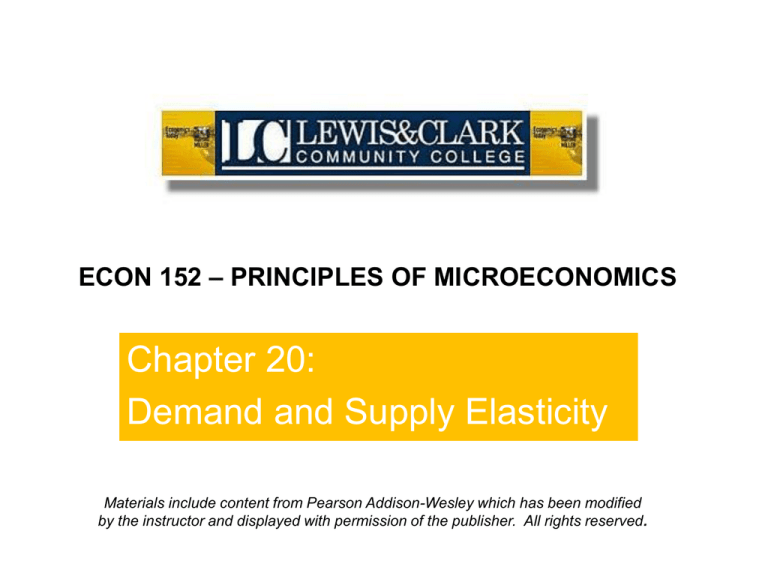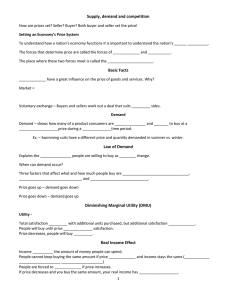
ECON 152 – PRINCIPLES OF MICROECONOMICS
Chapter 20:
Demand and Supply Elasticity
Materials include content from Pearson Addison-Wesley which has been modified
by the instructor and displayed with permission of the publisher. All rights reserved.
Price Elasticity
Price Elasticity of Demand (Ep)
The
responsiveness of quantity demanded of a
commodity to changes in its price
Ep =
percentage change in quantity demanded
percentage change in price
2
Price Elasticity
Example
Price
of oil increases 10 percent
Quantity demanded decreases 1 percent
-1%
Ep =
= -.1
+10%
3
Price Elasticity
Relative quantities only
Elasticity
is measuring the change in quantity
relative to the change in price
Always negative
An
increase in price decreases the quantity
demanded, ceteris paribus
4
Calculating Elasticity
Elasticity formula:
Ep =
or
change in Q
change in P
sum of quantities/2
sum of quantities/2
Ep =
change in Q
change in P
(Q1 + Q2)/2
(P1 + P2)/2
5
Price Elasticity Ranges
Elastic Demand
Percentage change in quantity demanded is larger
than the percentage change in price
Ep > 1
Unit Elasticity of Demand
Percentage change in quantity demanded is equal to
the percentage change in price
Ep = 1
Inelastic Demand
Percentage change in quantity demanded is smaller
than the percentage change in price
Ep < 1
6
Price Elasticity Ranges
Extreme elasticities
Perfectly
Inelastic Demand
A demand curve that is a vertical line
It has only one quantity demanded for each price
No matter what the price, quantity demanded does
not change
7
Extreme Price Elasticities
D
Price
Perfect inelasticity,
or zero elasticity
0
Figure 21-1, Panel (a)
8
Quantity Demanded per Year
(millions of units)
8
Price Elasticity Ranges
Extreme elasticities
Perfectly
Elastic Demand
A demand curve that is a horizontal line
It has only one price for every quantity
The slightest increase in price leads to zero
quantity demanded
9
Price (cents)
Extreme Price Elasticities
30
D
Perfect elasticity,
or infinite elasticity
0
Figure 21-1, Panel (b)
Quantity Demanded per Year
(millions of units)
10
Policy Example:
Who Pays Gasoline Taxes?
State and federal governments impose
gasoline taxes that are assessed as a
flat amount per gallon.
Who pays the tax depends on price
elasticity of demand.
11
Policy Example:
Who Pays Gasoline Taxes?
Figure 21-2, Panels (a) and (b)
12
Policy Example:
Who Pays Gasoline Taxes?
D
Figure 21-2, Panel (c)
13
Elasticity and Total Revenues
When demand is elastic, a negative relationship
exists between small changes in price and
changes in total revenue.
When demand is unit-elastic, changes in price
do not change total revenue.
When demand is inelastic, a positive relationship
exists between changes in price and total
revenues.
14
15
Determinants of
Price Elasticity of Demand
Existence of substitutes
The
closer the substitutes and the more
substitutes there are, the more elastic is
demand.
Share of the budget
The
greater the share of the consumer’s total
budget spent on a good, the greater is the
price elasticity.
16
Determinants of
Price Elasticity of Demand
The length of time allowed for adjustment
The
longer any price change persists, the
greater is the price elasticity of demand.
Price elasticity is greater in the long-run than in the
short-run.
17
Determinants of
Price Elasticity of Demand
How to define the short run and the
long run
The
short run is a time period too short
for consumers to fully adjust to a price
change.
The long run is a time period long
enough for consumers to fully adjust to a
change in price other things constant.
18
Price per Unit
Short-Run and Long-Run
Price Elasticity of Demand
In the short run, quantity
demanded falls slightly.
However, with more time
for adjustment the
demand curve becomes
more elastic and quantity
demanded falls by a
greater amount.
P1
Pe
E
D2
D1
Q2 Q1 Qe
Quantity Demanded per Period
Figure 21-4
19
Price per Unit
Short-Run and Long-Run
Price Elasticity of Demand
In the short run, quantity
demanded falls slightly.
However, with more time
for adjustment the
demand curve becomes
more elastic and quantity
demanded falls by a
greater amount.
P1
Pe
E
D3
D2
D1
Q3 Q2 Q1 Qe
Quantity Demanded per Period
Figure 21-4
20
Example: Real-World
Elasticities of Demand
Table 21-2
21
Cross Price
Elasticity of Demand
Cross Price Elasticity of Demand (Exy)
The
percentage change in the demand for
one good (holding its price constant) divided
by the percentage change in the price of a
related good
The responsiveness of change in demand of
one good to the change in prices of related
goods
22
Cross Price
Elasticity of Demand
Formula for computing cross elasticity of
demand
Exy =
% change in demand for good X
% change in price of good Y
23
Cross Price
Elasticity of Demand
Substitutes
Exy
would be positive
An increase in the price of X would increase the
quantity of Y demanded at each price.
Complements
Exy
would be negative
An increase in the price of X would decrease the
quantity of Y demanded at each price.
24
Income Elasticity of Demand
Income Elasticity of Demand (Ei)
The
percentage change in demand for any
good, holding its price constant, divided by
the percentage change in income
The responsiveness of demand to changes in
income, holding the good’s relative
price constant
refers to a horizontal shift in the demand
curve in response to changes in income
25
Income Elasticity of Demand
Ei =
percentage change in demand
percentage change in income
Ei for a normal good is positive.
Ei for an inferior good is negative.
26
Income Elasticity of Demand
Formula:
Change in Quantity
Average Quantity
÷
Change in Income
Average Income
The income elasticity of demand can be either
negative or positive.
Remember that, in calculating the income
elasticity of demand, the price of the good is
assumed to be constant.
27
Elasticity of Supply
Price Elasticity of Supply (Ei)
The
responsiveness of the quantity supplied
of a commodity to a change in its price
The percentage change in quantity supplied
divided by the percentage change in price
28
Elasticity of Supply
Formula for computing price elasticity of
supply
ES =
percentage change in quantity supplied
percentage change in price
29
Elasticity of Supply
Classifying supply elasticities
Perfectly
Elastic Supply
Quantity supplied falls to zero when there is any
decrease in price.
The supply curve is horizontal at a given price.
30
Elasticity of Supply
Classifying supply elasticities
Perfectly
Inelastic Supply
Quantity supplied is constant no matter what
happens to price.
The supply curve is vertical at a given price.
31
The Extremes in Supply Curves
S’
Price per Unit
Perfect inelasticity
P1
S
Perfect elasticity
Q1
Quantity Supplied per Period
Figure 21-5
32
Elasticity of Supply
Price elasticity of supply and length of time
for adjustment
The
longer the time allowed for adjustment,
the more elastic is supply.
Firms can find ways to increase (or decrease)
output.
Resources can flow into (or out of) an industry
through expansion (or contraction) of existing
firms.
33
Short-Run and Long-Run
Price Elasticity of Supply
S1
S2
Price per Unit
S3
P1
Pe
E
Qe
Figure 21-6
As time passes the supply
curve rotates to S2 then to
S3 and quantity supplied
rises first to Q1 and then
to Q2.
Q1
Q2
Quantity Supplied per Period
34
ECON 152 – PRINCIPLES OF MICROECONOMICS
Chapter 20:
Demand and Supply Elasticity
Materials include content from Pearson Addison-Wesley which has been modified
by the instructor and displayed with permission of the publisher. All rights reserved.








